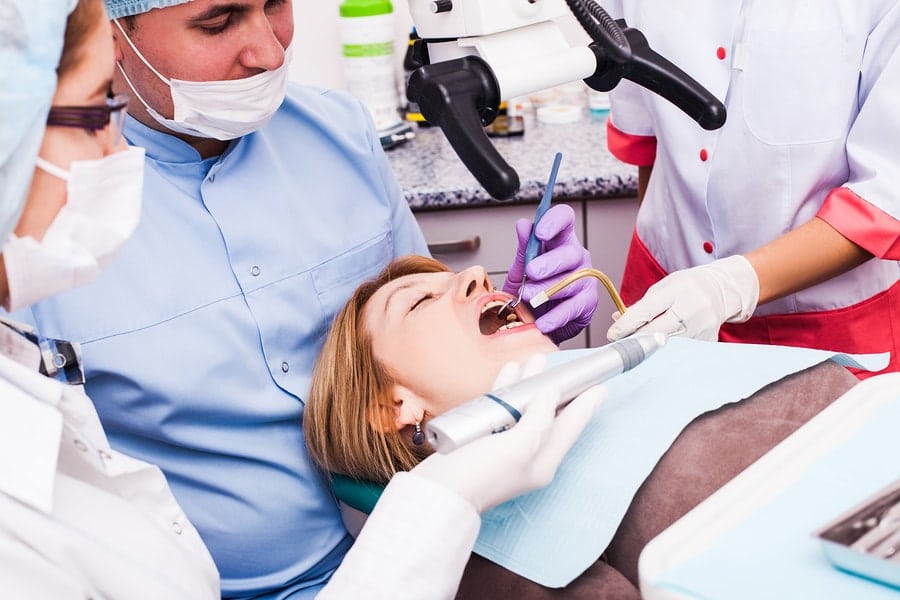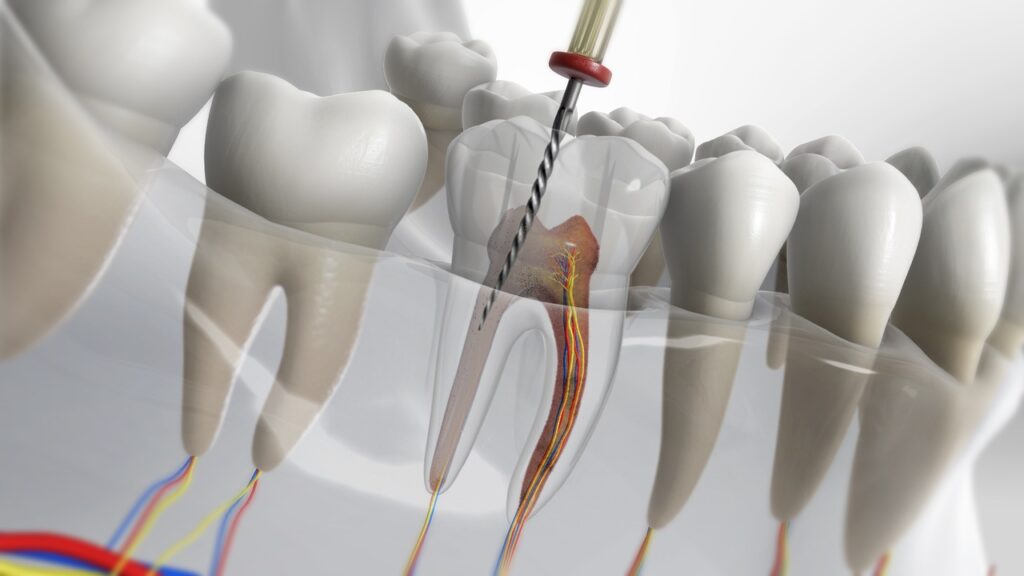Endodontics
Endodontics

Endodontists at Dental Solutions are experienced, efficient and trusted caregivers. The surgeons are well-trained and are knowledgeable in the usage of the latest equipment to treat patients quickly and comfortably. They are proficient in fixing and saving diseased teeth. As teeth-savers, they are valuable members of the dentist team.
Functions and scope of endodontics
- Root canal treatments: One of the primary therapeutic roles of endodontics is to provide root canal treatment in Bangalore. After careful removal of the pulp of the tooth, the inner surface of the tooth is cleaned, shaped and filled with protective material to seal the opening. Capping and placing of the crown on the tooth prevent further damage and degeneration.
- Surgery: Endodontists are skillfully endowed to perform hemisections (removal of part or half of a tooth), apicoectomies (amputating the root of the tooth) and in some cases where a tooth has to be removed from the mouth for oral treatment and replaced back into the socket. Tooth replacement procedures are done especially to save the patient’s tooth.
- Pain relief: Inexplicable pain in the face, jaw, and mouth are redirected to the endodontist due to their expertise in the field. They possess the equipment as well as the experience to diagnose hidden problems and treat them. Typically severe pains are caused due to infections, growths in the mouth and cracked tooth. These are determined by the endodontist and prescriptive medications are provided to relieve the pain.


Common endodontic treatments
- Fractured teeth: Dental fractures require emergency treatment that can be provided only by a trained endodontist or dentist. Temporizing measures are administered to avoid adverse results. Treatment of dental fractures requires knowledge, skill, expertise and a trained endodontist or dentist who can treat dental injuries. The intraoral lacerations are thoroughly examined for tooth fragments so that chronic infection is averted.
- Avulsed tooth: Avulsed tooth is an aesthetically displeasing and a very trying situation for an individual. An avulsed tooth ultimately requires root canal treatment to minimize periodontal damage and infection of the pulp. Ignoring avulsion of a tooth for long periods can result in misalignment due to shifting of teeth. Pulp necrosis and hypoxia are some results of avulsed tooth. Endodontics provides all treatments for avulsed tooth.
- Pulp polyp: Proliferative pulpitis or hyperplastic pulpitis is a type of inflammatory hyperplasia which is a fairly uncommon occurrence. Pulpitis can be reversible and irreversible. Noxious stimulus is removed and the pulp is returned back to its healthy state in the reversible pulpitis. Usually, the modalities of treatment chosen are tooth extraction and root canal treatment both of which are done by the endodontist.
- Pulp Stone: Pulp stones are endoliths that present as discrete calcified masses found in the dental pulp chamber. They are either embedded in the dentin or exist freely. The sizes and number of stones vary depending on the basis of the structure or on the basis of location. One tooth could contain up to 12 stones. They usually pose as a hindrance to root canal treatment. Pulp stones are surgically dissected or removed using ultrasonic endodontic tips.
Featured Endodontic Treatments at Dental Solutions
Single Visit Root Canal
Dental Solutions, Bangalore aims to bust another myth about root canal treatments. Traditionally complete sterility of the root canal before the obturation process required the procedure to take place in multiple sittings. With refined and advanced cleaning techniques a single visit is enough to achieve the desired results that RCT aims to provide. Efficient and effective outcomes can be obtained with titanium instrumentations, reliable and accurate apex locators, microscopic and laser endodontics, digital radiography, biocompatible sealants and other advanced obturation systems.
Repeat Root Canal
A root canal therapy can last for several years. But there could come a point in the lifetime of the RCT that the tooth does not heal and can become diseased and painful. The occurrence of degradation can be in months or even years. The tooth may even develop new problems. Root canal failures are indicative of re-treatment. The presence of pain and swelling in most cases can be treated successfully with both methods non-surgical endodontic re-RCT and surgical endodontic re-RCT. A retreatment entails removal of the tooth, the fillings and elimination of infection after a thorough examination of the canals. The tooth is once again, cleaned and shaped and new, temporary fillings are placed. Once healed, the crown is fitted on the top to protect the tooth. Better concepts, advanced techniques, and high levels of education have improved the quality of restorations.
Fiber-optic lighting systems, headlamps for better visualization, ultrasonic devices to painlessly and noiselessly remove the old root canal and repairing it and better medicaments for disinfection and filling have made re-RCTs much easier
Post and Core
Post and core procedures are done to anchor a crown or stabilize weakened tooth. When tooth structure is inadequate to reinforce a conventional restoration then a small rod or post is inserted into the root space with a few millimeters of protrusion. This protrusion which is the core supports the large crown or filling, whichever is appropriate. The missing coronal tooth structure is replaced sufficiently to restore full functionality and aesthetics of the tooth.
Dental inlays and Onlays
Restorations performed to rehabilitate the decayed, fractured or cracked teeth located in the rear are called inlays and onlays. They are also known as indirect fillings and are sometimes used as conservative alternatives to full coverage dental crowns. Inlays and onlays are long-lasting reparative solutions that successfully re-establish aesthetics and functionality of the damaged tooth. They fit well, are strong and a widely chosen alternative to traditional fillings. Tooth decay and structural damage are repaired with inlays and onlays fabricated in a dental laboratory and then bonded to the damaged tooth.
In an inlay the material is bonded into the centre of the tooth and in an onlay cusps may be included depending on the extent of damage and if full coverage of the biting surface is required.
Fiber-optic lighting systems, headlamps for better visualization, ultrasonic devices to painlessly and noiselessly remove the old root canal and repairing it and better medicaments for disinfection and filling have made re-RCTs much easier.
Conservative Endodontics
Conservative dentistry in endodontics deals with the preservation of teeth. It is ideally a combination of operative dentistry and endodontics. The specialty encompasses restoration and preservation techniques of teeth and the diagnosis and treatment of dental caries to re-establish full functionality and aesthetics of the tooth.
Pits and Fissures
Tooth decay is a common oral problem and most of the adults between the ages of 20 and 64 years suffer from tooth decay. The chewing surfaces of the teeth develop deep grooves called pits and fissures. They are found on the molars and premolars. The cavities in the molars are deeper than in the premolars. While chewing food may not be an issue food can still get stuck and form a bacterial film called plaque that accumulates if not cleaned regularly. A regular toothbrush may not be able to remove the food particles stuck in these areas. So the plaque stays in place and causes a cavity. A narrowed morphology provides the perfect space for the development of caries. Molars are the first set of permanent teeth and are the most susceptible set of teeth to occlusal caries.
In an inlay the material is bonded into the centre of the tooth and in an onlay cusps may be included depending on the extent of damage and if full coverage of the biting surface is required.
Microscopic Endodontics
Dental operating microscopes are considered as one of the best innovations in dentistry. Macro-dentistry drew a closure with the introduction of precision through micro-dentistry. Dentists can work under high magnifications and resolutions to derive better and accurate results. The success of root canal treatments took a gigantic leap with the introduction of microscopes in dentistry for procedural execution. There are several advantages to using the microscope –
- It can retrieve broken instruments
- Endodontic treatments tend to be more accurate than other conventional treatments
